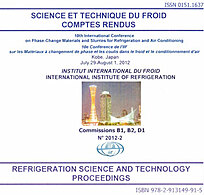
Résumé
Using supercooled water to generate ice slurry is one of the promising methods due to its high efficiency and energy saving; however, the ice blocking happened in supercooler is a problem that will reduce the efficiency of the ice-making system. In order to avoid/retard ice blocking or increase the time of ice production in a dynamic system using supercooled water, a nano-fluorocarbon coating was coated on the supercooler in this study. Effects of the nano-fluorocarbon coating on the ice-making system which was combined by three different parts were studied experimentally. Compared with the uncoated supercooler, the experiments were conducted based on the different parameters: the temperature of the supercooled water, the supercooling degree, the start time of ice blockage and the flow rate. The experimental data were obtained by a data acquisition system, then were analysed and discussed. Finally, it was observed that the supercooler coated with the nano-fluorocarbon coating could be applied to retard ice-blocking thanks to the properties of the coated surface.
Documents disponibles
Format PDF
Pages : 7 p.
Disponible
Prix public
20 €
Prix membre*
Gratuit
* meilleur tarif applicable selon le type d'adhésion (voir le détail des avantages des adhésions individuelles et collectives)
Détails
- Titre original : Investigation into the supercooler coated with nano-fluorocarbon film in the dynamic ice-making system..
- Identifiant de la fiche : 30005092
- Langues : Anglais
- Source : 10th International Conference on Phase-Change Materials and Slurries for Refrigeration and Air Conditioning. Proceedings: Kobe, Japan, July 29-August 1, 2012.
- Date d'édition : 01/07/2012
Liens
Voir d'autres communications du même compte rendu (46)
Voir le compte rendu de la conférence
Indexation
-
Analysis on IPF influencing factors for vacuum ...
- Auteurs : ZHANG X., WU Y., LI Z., et al.
- Date : 01/07/2012
- Langues : Anglais
- Source : 10th International Conference on Phase-Change Materials and Slurries for Refrigeration and Air Conditioning. Proceedings: Kobe, Japan, July 29-August 1, 2012.
- Formats : PDF
Voir la fiche
-
Research on characteristics of binary ice prepa...
- Auteurs : ZHANG X. L., YU M., YU S. X., et al.
- Date : 21/08/2011
- Langues : Anglais
- Source : Proceedings of the 23rd IIR International Congress of Refrigeration: Prague, Czech Republic, August 21-26, 2011. Overarching theme: Refrigeration for Sustainable Development.
- Formats : PDF
Voir la fiche
-
Experimental investigation on the supercooling ...
- Auteurs : GUND S., KAUFFELD M.
- Date : 24/08/2019
- Langues : Anglais
- Source : Proceedings of the 25th IIR International Congress of Refrigeration: Montréal , Canada, August 24-30, 2019.
- Formats : PDF
Voir la fiche
-
Experimental characterization of the icephobic ...
- Auteurs : SAMAH W., CLAIN P., RIOUAL F., FOURNAISON L., DELAHAYE A.
- Date : 21/08/2023
- Langues : Anglais
- Source : Proceedings of the 26th IIR International Congress of Refrigeration: Paris , France, August 21-25, 2023.
- Formats : PDF
Voir la fiche
-
Numerical simulation on the phase change proces...
- Auteurs : DU Q., LIN W., CHEN M., YU T., CHEN Y., SONG W., LI Y., FENG Z.
- Date : 31/05/2024
- Langues : Anglais
- Source : 14th IIR Conference on Phase-Change Materials and Slurries for Refrigeration and Air Conditioning. Proceedings: Paris France, May 29-31, 2024.
- Formats : PDF
Voir la fiche
